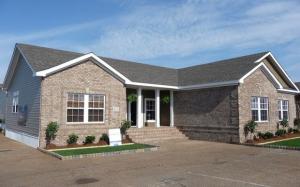The Global Manufactured Housing Market is experiencing notable growth due to several key market drivers.
VT, UNITED STATES, January 20, 2025 /EINPresswire.com/ --The manufactured housing market represents a vital segment of the housing industry, offering affordable and versatile housing solutions for millions of people worldwide. This market has seen significant evolution over the years, driven by changes in consumer preferences, regulatory shifts, technological advancements, and broader economic factors. This article explores the dynamics of the manufactured housing market, examining its history, trends, challenges, and future prospects.
Defining Manufactured Housing
Manufactured housing refers to homes built in a factory setting and then transported to their final location for installation. Unlike traditional site-built homes, these structures are constructed under controlled conditions, adhering to specific standards and regulations. In the United States, for example, manufactured homes must comply with the HUD (Department of Housing and Urban Development) Code, ensuring quality, safety, and energy efficiency.
Manufactured housing is distinct from modular housing, which is also factory-built but follows local building codes rather than a federal standard. Manufactured homes often serve as an affordable alternative for low- to moderate-income families, retirees, and individuals seeking cost-effective housing solutions.
Download Report Sample Copy: https://www.wiseguyreports.com/sample-request?id=652510
Market Size and Growth Trends
The global manufactured housing market has experienced steady growth in recent years, driven by increasing demand for affordable housing and the need to address housing shortages in urban and rural areas. The Manufactured Housing Market was valued at USD 36.68 billion in 2023 and is projected to grow from USD 37.88 billion in 2024 to USD 49.0 billion by 2032, with a compound annual growth rate (CAGR) of approximately 3.27% during the forecast period from 2025 to 2032.
Several factors contribute to the market’s expansion:
Affordability: Manufactured homes cost significantly less than site-built homes, making them an attractive option for buyers with limited budgets. According to recent estimates, the average price per square foot for manufactured housing is about half that of traditional homes.
Technological Advancements: Improvements in construction techniques and materials have enhanced the durability, energy efficiency, and aesthetic appeal of manufactured homes. Modern designs often include features such as solar panels, smart home technology, and customizable layouts.
Urbanization and Housing Shortages: Rapid urbanization has led to housing shortages in many regions, prompting governments and developers to consider manufactured housing as a viable solution to meet growing demand.
Shift in Consumer Preferences: Younger generations and retirees alike are embracing manufactured housing for its affordability, flexibility, and ability to provide a sustainable living environment.
Key Companies in the Manufactured Housing Market Include:
Nexus Quality Homes
Redman Homes
Cypress Home Solutions
Fleetwood Homes
Karsten Homes
Skyline Champion Corporation
Destiny Homes
Champion Home Builders
Clayton Homes
Palm Harbor Homes
Eagle Home Mortgage
Cavco Industries
Southern Energy
Schult Homes
Marlette Homes
Buy Now: https://www.wiseguyreports.com/checkout?currency=one_user-USD&report_id=652510
Challenges in the Manufactured Housing Market
Despite its many advantages, the manufactured housing market faces several challenges that could hinder its growth potential:
Stigma and Perception: Manufactured homes are often associated with outdated stereotypes of "mobile homes" or "trailer parks." This stigma can affect consumer perception and willingness to invest in such properties.
Zoning and Regulatory Barriers: Zoning restrictions and land-use policies in many regions limit where manufactured homes can be placed. Local governments often favor site-built homes, creating obstacles for developers and buyers of manufactured housing.
Financing Difficulties: Obtaining financing for manufactured homes can be more challenging than for traditional homes. Many lenders classify these properties as personal property rather than real estate, leading to higher interest rates and shorter loan terms.
Land Ownership Issues: A significant proportion of manufactured homes are located on leased land, which can lead to uncertainties about tenure and long-term value.
Environmental Concerns: While modern manufactured homes are more energy-efficient, the production and transportation processes still raise environmental concerns. Additionally, older units that are no longer in use often pose disposal challenges.
Future Outlook
The future of the manufactured housing market appears promising, with several trends shaping its trajectory:
Increased Adoption of Green Building Practices: Manufacturers are increasingly focusing on sustainability, incorporating eco-friendly materials and energy-efficient systems into their designs. This trend aligns with growing consumer awareness of environmental issues and government incentives for green housing.
Expansion in Emerging Markets: As urbanization accelerates in developing countries, the demand for affordable housing solutions is expected to rise. Manufactured housing offers a cost-effective and scalable option to meet this demand.
Integration of Smart Technologies: The incorporation of smart home features, such as automated lighting, climate control, and security systems, is likely to enhance the appeal of manufactured homes among tech-savvy buyers.
Government Support and Incentives: Policymakers in many regions are recognizing the potential of manufactured housing to address housing shortages. Initiatives such as tax breaks, grants, and subsidies could further boost market growth.
Innovative Designs and Customization: Manufacturers are investing in research and development to create homes that meet diverse consumer preferences, including multi-family units, luxury designs, and homes tailored for specific climates or terrains.
Table of Contents
SECTION I: EXECUTIVE SUMMARY AND KEY HIGHLIGHTS
EXECUTIVE SUMMARY
• Market Overview
• Key Findings
• Market Segmentation
• Competitive Landscape
• Challenges and Opportunities
• Future Outlook
SECTION II: SCOPING, METHODOLOGY AND MARKET STRUCTURE
SECTION III: QUALITATIVE ANALYSIS
SECTION IV: QUANTITATIVE ANALYSIS
SECTION V: COMPETITIVE ANALYSIS
LIST Of tables
LIST Of figures
Related Reports
Ductless HVAC System Market https://www.wiseguyreports.com/reports/ductless-hvac-system-market
Rail Tunnel Construction Market https://www.wiseguyreports.com/reports/rail-tunnel-construction-market
Tunnel and Metro Market https://www.wiseguyreports.com/reports/tunnel-and-metro-market
Plastic Tube Packaging Market https://www.wiseguyreports.com/reports/plastic-tube-packaging-market
Steel Tubular Piling Pipe Market https://www.wiseguyreports.com/reports/steel-tubular-piling-pipe-market
Asphalt paving machines Market https://www.wiseguyreports.com/reports/asphalt-paving-machines-market
Stretch Films Packaging https://www.wiseguyreports.com/reports/stretch-films-packaging-market
WiseGuyReports (WGR)
WISEGUY RESEARCH CONSULTANTS PVT LTD
+ 1 628-258-0070
email us here
Legal Disclaimer:
EIN Presswire provides this news content "as is" without warranty of any kind. We do not accept any responsibility or liability for the accuracy, content, images, videos, licenses, completeness, legality, or reliability of the information contained in this article. If you have any complaints or copyright issues related to this article, kindly contact the author above.


